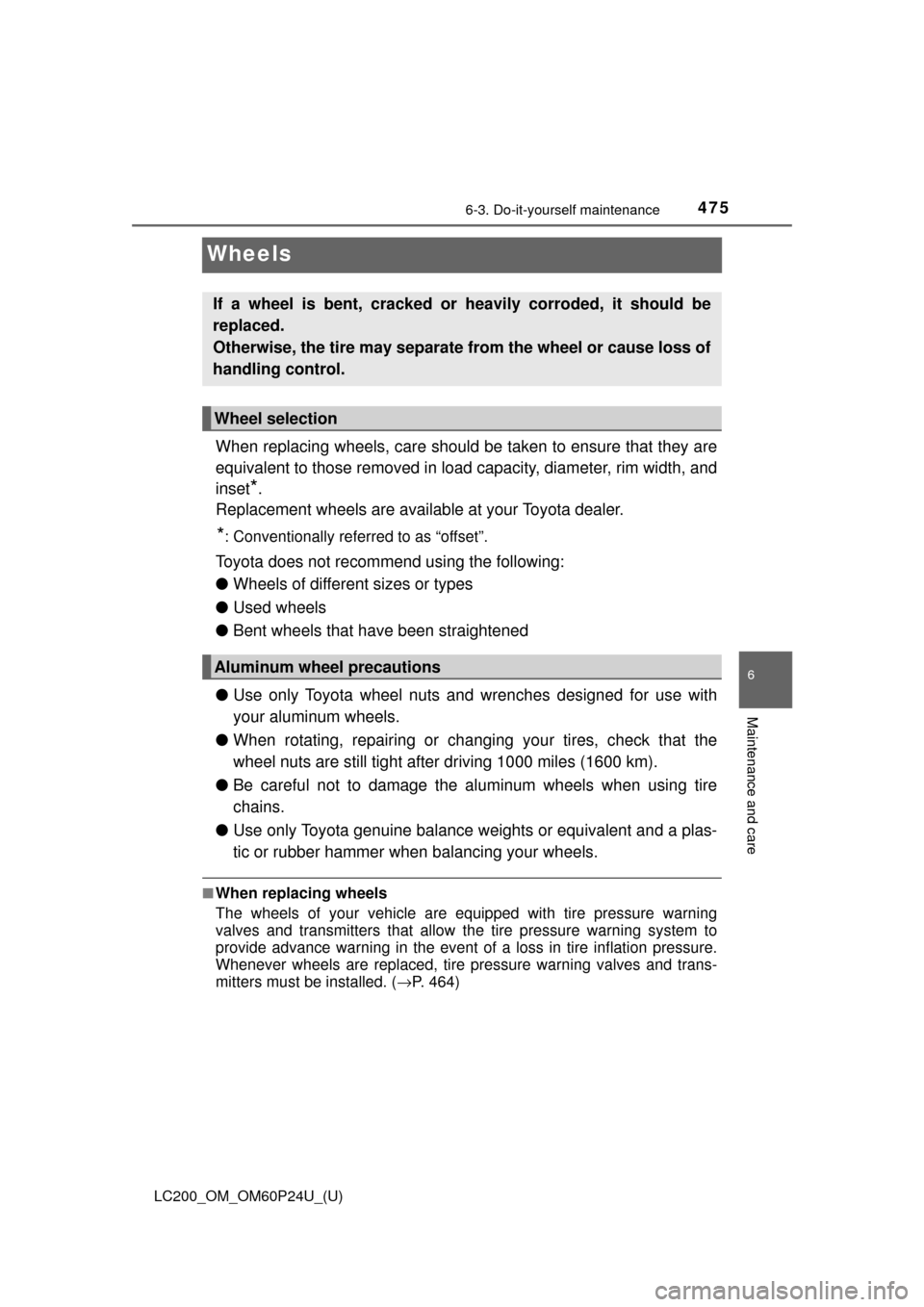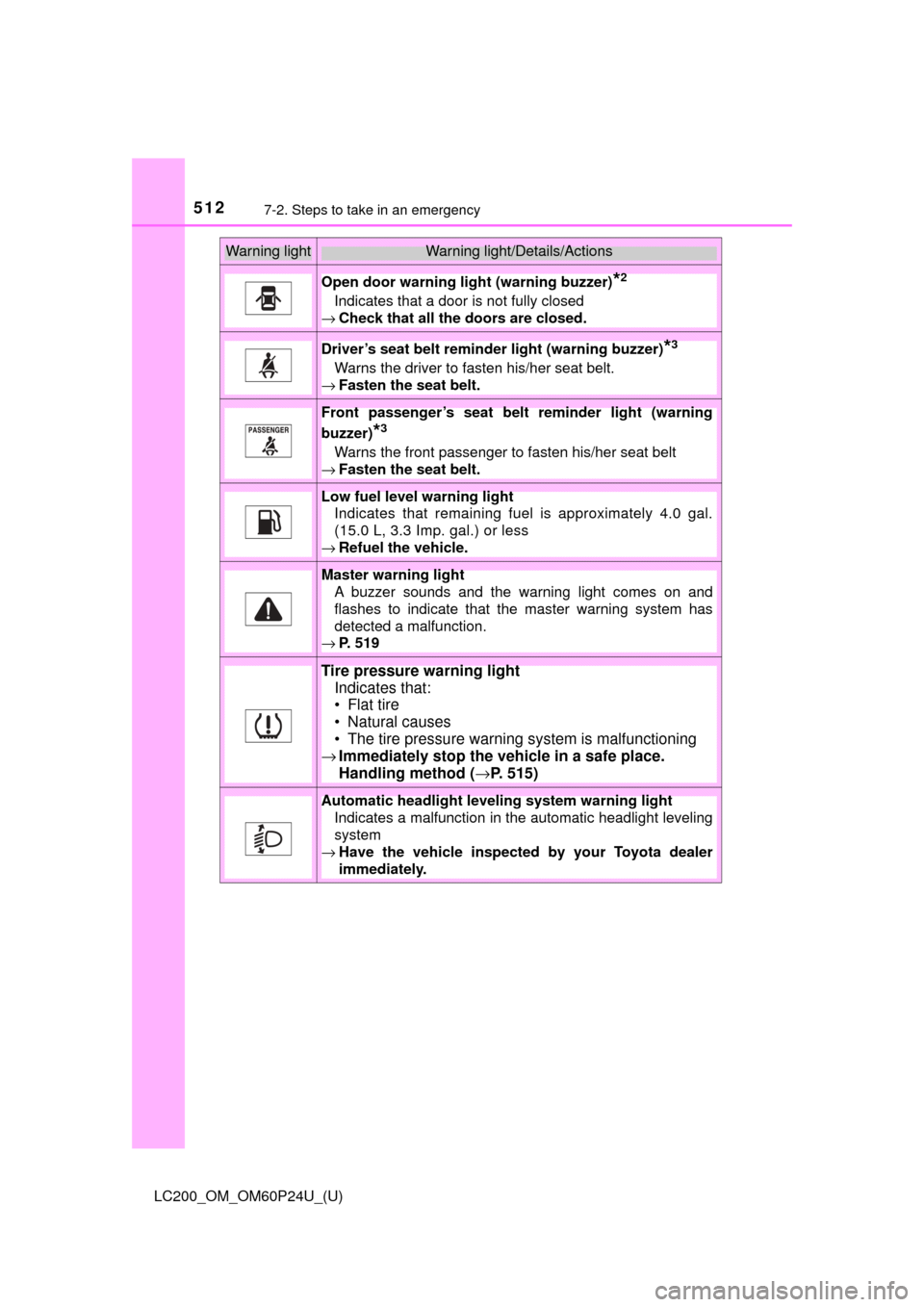2017 TOYOTA LAND CRUISER flat tire
[x] Cancel search: flat tirePage 474 of 608

474
LC200_OM_OM60P24U_(U)
6-3. Do-it-yourself maintenance
■Instructions for checking tire inflation pressure
When checking tire inflation pressure, observe the following:
●Check only when the tires are cold.
If your vehicle has been parked for at least 3 hours and has not been
driven for more than 1 mile or 1.5 km, you will get an accurate cold tire
inflation pressure reading.
●Always use a tire pressure gauge.
It is difficult to judge if a tire is properly inflated based only on its appear-
ance.
●It is normal for the tire inflation pressure to be higher after driving as
heat is generated in the tire. Do no t reduce tire inflation pressure after
driving.
●Never exceed the vehicle capacity weight.
Passengers and luggage weight should be placed so that the vehicle is
balanced.
WARNING
■Proper inflation is critical to save tire performance
Keep your tires properly inflated.
If the tires are not properly inflated, the following conditions may occur
which could lead to an accident resulting in death or serious injury:
●Excessive wear
●Uneven wear
●Poor handling
●Possibility of blowouts resulting from overheated tires
●Air leaking from between tire and wheel
●Wheel deformation and/ or tire damage
●Greater possibility of ti re damage while driving (due to road hazards,
expansion joints, sharp edges in the road, etc.)
NOTICE
■When inspecting and adjusting tire inflation pressure
Be sure to put the tire valve caps back on.
If a valve cap is not installed, dirt or moisture may get into the valve and
cause an air leak, resulting in decreased tire inflation pressure.
Page 475 of 608

475
LC200_OM_OM60P24U_(U)
6-3. Do-it-yourself maintenance
6
Maintenance and care
Wheels
When replacing wheels, care should be taken to ensure that they are
equivalent to those removed in load capacity, diameter, rim width, and
inset
*.
Replacement wheels are available at your Toyota dealer.
*: Conventionally referred to as “offset”.
Toyota does not recommend using the following:
● Wheels of different sizes or types
● Used wheels
● Bent wheels that have been straightened
● Use only Toyota wheel nuts and wrenches designed for use with
your aluminum wheels.
● When rotating, repairing or changi ng your tires, check that the
wheel nuts are still tight after driving 1000 miles (1600 km).
● Be careful not to damage the aluminum wheels when using tire
chains.
● Use only Toyota genuine balance we ights or equivalent and a plas-
tic or rubber hammer when balancing your wheels.
■When replacing wheels
The wheels of your vehicle are equipped with tire pressure warning
valves and transmitters that allow the tire pressure warning system to
provide advance warning in the event of a loss in tire inflation pressure.
Whenever wheels are replaced, tire pressure warning valves and trans-
mitters must be installed. ( →P. 464)
If a wheel is bent, cracked or heavily corroded, it should be
replaced.
Otherwise, the tire may separate from the wheel or cause loss of
handling control.
Wheel selection
Aluminum wheel precautions
Page 499 of 608

499
LC200_OM_OM60P24U_(U)
7When trouble arises
7-1. Essential informationEmergency flashers .......... 500
If your vehicle has to be stopped in
an emergency ................. 501
7-2. Steps to take in an emergency
If your vehicle needs to be towed ..................... 502
If you think something is wrong .............................. 508
Fuel pump shut off system ............................ 509
If a warning light turns on or a warning buzzer
sounds ............................ 510
If a warning message is displayed......................... 519
If you have a flat tire.......... 524
If the engine will not start ................................. 538
If the electronic key does not operate properly........ 540
If the vehicle battery is discharged ...................... 543
If your vehicle overheats ... 546
If the vehicle becomes stuck ............................... 549
Page 508 of 608

508
LC200_OM_OM60P24U_(U)
7-2. Steps to take in an emergency
If you think something is wrong
●Fluid leaks under the vehicle
(Water dripping from the air co nditioning after use is normal.)
● Flat-looking tires or uneven tire wear
● Engine coolant temperature gauge needle continually points higher
than normal
● Engine oil pressure gauge continually points lower than normal.
● Voltmeter continually points higher or lower than normal.
● Changes in exhaust sound
● Excessive tire squeal when cornering
● Strange noises related to the suspension system
● Pinging or other noises related to the engine
● Engine missing, stumbling or running roughly
● Appreciable loss of power
● Vehicle pulls heavily to one side when braking
● Vehicle pulls heavily to one side when driving on a level road
● Loss of brake effectiveness, spon gy feeling, pedal almost touches
the floor
If you notice any of the follow ing symptoms, your vehicle proba-
bly needs adjustment or repair. Contact your Toyota dealer as
soon as possible.
Visible symptoms
Audible symptoms
Operational symptoms
Page 512 of 608

5127-2. Steps to take in an emergency
LC200_OM_OM60P24U_(U)
Open door warning light (warning buzzer)*2
Indicates that a door is not fully closed
→ Check that all the doors are closed.
Driver’s seat belt reminder light (warning buzzer)*3
Warns the driver to fasten his/her seat belt.
→ Fasten the seat belt.
Front passenger’s seat belt reminder light (warning
buzzer)
*3
Warns the front passenger to fasten his/her seat belt
→ Fasten the seat belt.
Low fuel level warning light
Indicates that remaining fuel is approximately 4.0 gal.
(15.0 L, 3.3 Imp. gal.) or less
→ Refuel the vehicle.
Master warning light
A buzzer sounds and the warning light comes on and
flashes to indicate that the master warning system has
detected a malfunction.
→ P. 519
Tire pressure warning light
Indicates that:
• Flat tire
• Natural causes
• The tire pressure warning system is malfunctioning
→ Immediately stop the vehicle in a safe place.
Handling method ( →P. 515)
Automatic headlight leveling system warning light
Indicates a malfunction in the automatic headlight leveling
system
→ Have the vehicle inspected by your Toyota dealer
immediately.
Warning lightWarning light/Details/Actions
Page 515 of 608

5157-2. Steps to take in an emergency
LC200_OM_OM60P24U_(U)
7
When trouble arises
■When the tire pressure warning light comes on
Inspect the tires to check if a tire is punctured.
If a tire is punctured: →P. 524
If none of the tires are punctured:
Turn the engine switch off then turn it to IGNITION ON mode. Check if the
tire pressure warning light comes on or flashes.
If the tire pressure warning light comes on
After the temperature of the tires has lowered sufficiently, check the
inflation pressure of each tire and adjust them to the specified level.
If the warning light does not turn off even after several minutes have
elapsed, check that the inflation pressure of each tire is at the specified
level and perform initialization. (→P. 464)
If the warning light does not turn off even after several minutes have
elapsed, have the vehicle inspected by your Toyota dealer immediately.
If the tire pressure warning light flashes for 1 minute then stay on
There may be a malfunction in the tire pressure warning system. Have
the vehicle inspected by your Toyota dealer immediately.
■The tire pressure warning light may turn on due to natural causes
The tire pressure warning light may turn on due to natural causes such as
natural air leaks or tire inflation pressure changes caused by tempera-
ture. In this case, adjusting the tire inflation pressure will turn off the warn-
ing light (after a few minutes).
■When a tire is replaced with a spare tire
The spare tire is also equipped with the tire pressure warning valve and
transmitter. The tire pres sure warning light will turn on if the tire inflation
pressure of the spare tire is low. If a tire goes flat, even though the flat tire
is replaced with the spare tire, the tire pressure warning light does not
turn off. Replace the spare tire with the repaired tire and adjust the proper
tire inflation pressure. The tire pres sure warning light will turn off after a
few minutes.
■Conditions that the tire pressure warning system may not function
properly
→ P. 4 6 8
■Changing the engine oil
Make sure to reset oil change system.
1
2
Page 516 of 608

5167-2. Steps to take in an emergency
LC200_OM_OM60P24U_(U)■
Warning buzzer
In some cases, the buzzer may not be heard due to being in a noisy location
or audio sound.
WARNING
■If both the ABS and the brake system warning lights remain on
Stop your vehicle in a safe place immediately and contact your Toyota
dealer. The vehicle will become extremely unstable during braking, and the
ABS system may fail, which could cause an accident resulting in death or
serious injury.
■
If the tire pressure warning light comes on
Be sure to observe the following precautions. Failure to do so could
cause loss of vehicle control and result in death or serious injury.
●Stop your vehicle in a safe place as soon as possible. Adjust the tire
inflation pressure immediately.
●If the tire pressure warning light co mes on even after tire inflation pres-
sure adjustment, it is probable that you have a flat tire. Check the tires.
If the tire is flat, change to the spare tire and have the flat tire repaired
by the nearest Toyota dealer.
●Avoid abrupt maneuvering and braking. If the vehicle tires deteriorate,
you could lose control of the steering wheel or the brakes.
■If a blowout or sudden air leakage should occur
The tire pressure warning system may not activate immediately.
Page 517 of 608

5177-2. Steps to take in an emergency
LC200_OM_OM60P24U_(U)
7
When trouble arises
WARNING
■Maintenance of the tires
Each tire, including the spare (if provided), should be checked monthly
when cold and inflated to the inflation pressure recommended by the
vehicle manufacturer on the vehicle placard or tire inflation pressure
label (tire and load information label). (If your vehicle has tires of a dif-
ferent size than the size indicated on the vehicle placard or tire inflation
pressure label [tire and load information label], you should determine
the proper tire inflation pressure for those tires.)
As an added safety feature, your vehicle has been equipped with a tire
pressure monitoring system (TPMS-ti re pressure warning system) that
illuminates a low tire pre ssure telltale (tire pressure warning light) when
one or more of your tires is significantly under-inflated. Accordingly,
when the low tire pressure telltale (tire pressure warning light) illumi-
nates, you should stop and check your tires as soon as possible, and
inflate them to the proper pressure. Driving on a significantly under-
inflated tire causes the tire to overheat and can lead to tire failure.
Under-inflation also reduces fuel effi ciency and tire tread life, and may
affect the vehicle’s handling and stopping ability.
Please note that the TPMS (tire pressure warning system) is not a sub-
stitute for proper ti re maintenance, and it is the driver’s responsibility to
maintain correct tire pressure, even if under-inflation has not reached
the level to trigger illumination of the TPMS low tire pressure telltale (tire
pressure warning light).
Your vehicle has also been equipped with a TPMS (tire pressure warn-
ing system) malfunction indicator to indicate when the system is not
operating properly. The TPMS (tire pressure warning system) malfunc-
tion indicator is combined with the lo w tire pressure telltale (tire pressure
warning light). When the system detects a malfunction, the telltale will
flash for approximately one minute and then remain continuously illumi-
nated. This sequence will continue upon subsequent vehicle start-ups as long as the malfunction exists. When the malfunction indicator is illu-
minated, the system may not be able to detect or signal low tire pres-
sure as intended.
TPMS (tire pressure warning system) malfunctions may occur for a vari-
ety of reasons, including the installation of replacement or alternate tires
or wheels on the vehicle that prevent the TPMS (tire pressure warning
system) from functioning properly. Always check the TPMS (tire pres-
sure warning system) malfunction te lltale after replacing one or more
tires or wheels on your vehicle to ensure that the replacement or alter-
nate tires and wheels allow the TPMS (tire pressure warning system) to
continue to function properly.